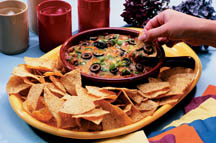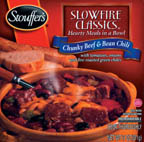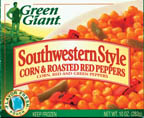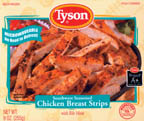
As time progressed, the missionary nuns of Mexico developed new foods combining products of both the Indian and Spanish cultures, such as mole poblano, which is made of a spiced chocolate sauce laden with fruits, nuts and chilies, served over meat such as chicken.
Mexican-style cooking spread along the Southwest border of the U.S., and American Indians and frontier cooks adapted ingredients, cooking techniques and flavors to their tastes. New food ingredients such as corn, squash, melons and pumpkins, were eventually added to their diets.
Today, dishes such as tacos, burritos, enchiladas, chili (authentic chili has no beans) and salsa make up an important part of Tex-Mex cuisine. Other popular items are beef fajitas made of skirt steak; flautas, corn tortillas that are filled with shredded chicken or meat and then deep fried; and carnitas, pork chunks in red ancho chile sauce. The cuisine also features tortillas, rice, beans, corn, potatoes, cheese, cilantro, squash and onions.

Chiles: Some Like it Hot
Beyond the Texas borders, some of the best chile peppers are grown in New Mexico, due to the ideal climate, soil and extensive knowledge of the farmers. There are many Tex-Mex and Southwestern signature dishes that use green and red chiles.The spelling of chiles varies—to the Spanish it is chiles and to the Americans it is chilies. There are over 200 known varieties of fresh and dried chiles in the Capsicum family. They range from mild to hot, green to red, small to large, fresh to dry.
The chile's seeds and ribs hold 80% of the pepper's heat. Neither cooking nor freezing diminishes this. However, removing the seeds and ribs reduces the heat.

Varieties of Tex-Mex Chiles
Jalapeno- When fresh, they are dark green chiles with a thick flesh. They are used to heat up many Tex-Mex dishes such as salsas and sauces. When ripe, they turn red and have a sweeter flavor. After being dried and smoked, they are called chipotles.Poblano - When fresh, they are dark green to purple in color. They are usually roasted, which gives them a smoky and earthy flavor. Poblano chiles are less fiery than jalapenos. They are used to make dishes such as rellenos (stuffed, fried peppers), and mole and pipian sauces. Dried poblanos are called anchos, which have a sweet and woody fruit flavor.
Guajillo - These are dried chiles that have a medium hot taste and are used in salsas, sauces and soups. The shiny, deep orange and brown colored pod has a green tea and piney flavor. The tough skin usually requires a long period of rehydration.

Ground chile - 100% pure ground chile. Often mistaken for chili powder.
Chili powder - A mixture of ground chili, garlic powder, Mexican oregano, cumin and salt. Often used as a main season ingredient to make chili.
What Makes it Tex-Mex?
Over 60% of the Texas population can trace its ancestors back to Mexico, so it comes as no surprise that Tex-Mex cooking is one thing for which the state is famous. Tex-Mex foods are most popular in South Central Texas (Austin and San Antonio), where serious chefs and food professionals regularly argue about whether or not to add beans to a pot of chili.Frequently used Tex-Mex ingredients are cilantro, garlic, shortening, sour cream, masa (dried ground corn used to make tortillas and tomatoes), beans, avocados and chorizo, a spicy Mexican (Spanish influenced) pork sausage.
Tex-Mex cooking often is described as contemporary. Foods such as tacos, burritos, quesadillas and chili are versatile and can be prepared easily and quickly.
Southwestern cooking involves more detailed cooking techniques. Some signature Southwestern foods are chile rellenos casserole, black bean soup, and bunuelos, a fried bread eaten with sprinkled sugar and cinnamon.